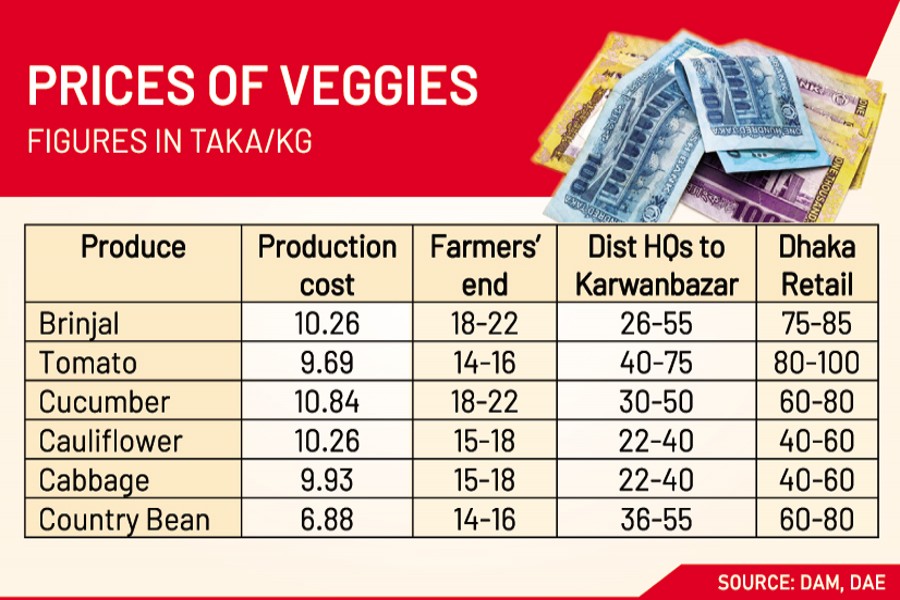
Huge farm-to-city price gap keeps veggie costs high
Agri items pass through six intermediaries before reaching city consumers
YASIR WARDAD | Monday, 18 December 2023

While vegetable prices at farms have dropped in the past two weeks, retail customers in Dhaka hardly reaped the benefits thanks to whopping 80-450 per cent price gaps between fields and city kitchen markets.
In government data, the gap is attributed to a weak and outdated value chain lacking proper regulation.
For instance, take the case of Hadisur Rahman, a farmer at Shatibari in Rangpur district, who was selling cauliflowers to city traders for Tk15-18 per piece last week.
The same cauliflower fetched Tk22-26 in Rangpur, Tk38-40 in Dhaka's Karwan Bazar and eventually reached a staggering Tk45-60 at the capital's retail markets on Sunday.
However, the Department of Agricultural Marketing (DAM) says the maximum production cost of cauliflower this year is Tk11 per piece.
Similar price discrepancies were found for other vegetables.
Farmers sold cucumbers at Tk16-20 per kg, barely exceeding their production cost of Tk10.84. These reached Tk25-30 at district headquarters, Tk36-40 at Karwan Bazar and Tk50-65 at Dhaka retail markets, showed DAM data.
Haider Ali, a vegetable vendor in Dhaka's Dhanmondi-15 area, was selling brinjals at Tk80-85 per kg. He attributed this inflated price to wholesale rates of Tk70-75 at Karwan Bazar and Beribadh markets on Saturday.
While vegetable prices have been declining at the farm level, the vegetable vendor reported a recent increase in brinjal prices. Meanwhile, DAM's market report showed a production cost of Tk10.26 per kg for long brinjal.
Farmers sold them to district traders for Tk20-24, while the same produce traded at Tk32-40 in district towns and exceeded Tk55 at Karwan Bazar wholesale.
This story echoes across winter vegetables like cabbage, tomato, bean, radish, leafy greens, carrot, green chilli, pumpkin, potato and more, as per DAM data.
DAM's Research Director Omar Md Imrul Mohsin said vegetable prices have dropped 50-60 per cent at the farm level in the last two weeks due to simultaneous harvests across districts.
However, these declines haven't translated to city markets like Dhaka, Chittagong and Narayanganj, as prices remain stagnant or even inflated, he added.
While cyclonic storms in October and early November temporarily set back vegetable production, KJM Abdul Awal, director of the Department of Agricultural Extension's horticulture wing, reported favourable conditions amid recent temperature drops.
"The weather has become suitable now," said Mr Awal, optimistic about meeting the targeted acreage of 0.62 million hectares for this Rabi season.
He estimated over 90 per cent has already been achieved, with the remainder expected to be planted within the month. Despite the October and December losses, the official was confident of reaching the 14 million tonne production target.
However, SM Nazer Hossain, vice president of the Consumers Association of Bangladesh, paints a different price prospect for city consumers.
"There is no regulation in the vegetable market," he said, pointing out inflated prices of Tk60-100 per kg for various vegetables in this peak harvesting season.
Farm economist Prof Dr Rashidul Hasan linked the high city prices to limited farmer access to urban markets. "A key reason for the price disparity is that farmers are excluded from the city market," he commented.
According to Dr Hasan, the outdated value chain dominated by input businesses and city traders remains the core problem.
He said vegetables pass through six intermediaries before reaching consumers, unchanged from a decade ago.
"Without increasing farmer participation in the overall value chain, this price gap is impossible to eradicate," he added.
He recommended "regular market drives by government agencies" as the only viable option to lower the retail prices.
tonmoy.wardad@gmail.com